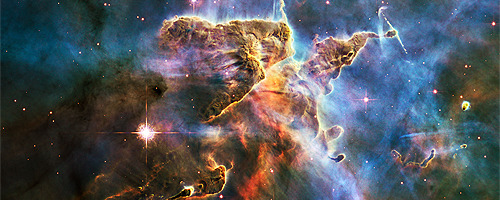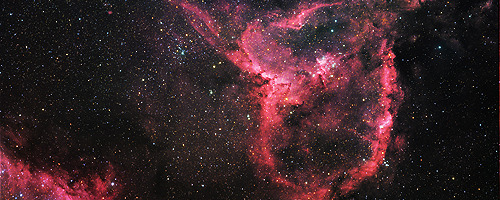The Carina Nebula - A Birthplace Of Stars

The Carina Nebula - A Birthplace Of Stars
The Carina Nebula lies at an estimated distance of 6,500 to 10,000 light years away from Earth in the constellation Carina. This nebula is one of the most well studied in astrophysics and has a high rate of star formation. The star-burst in the Carina region started around three million years ago when the nebula’s first generation of newborn stars condensed and ignited in the middle of a huge cloud of cold molecular hydrogen. Radiation from these stars carved out an expanding bubble of hot gas. The island-like clumps of dark clouds scattered across the nebula are nodules of dust and gas that are resisting being eaten away by photons (particles of light) that are ionizing the surrounding gas (giving it an electrical charge).
Credit: NASA/Hubble
More Posts from Study-astronomy-biology-ref and Others






Could dark energy be caused by frozen neutrinos?
“Since its discovery in 1998, the accelerated expansion has lacked a compelling, simple explanation that didn’t hypothesize a completely new set of forces, properties or interactions. If you wanted a scalar field — a quintessence model — it had to be finely tuned. But in a very clever paper just submitted yesterday by Fergus Simpson, Raul Jimenez, Carlos Pena-Garay, and Licia Verde, they note that if a generic scalar field couples to the neutrinos we have in our Universe, that fine-tuning goes away, and that scalar field will automatically begin behaving as a cosmological constant: as energy inherent to space itself.”
The accelerated expansion of our Universe was one of the biggest surprise discoveries of all-time, and something that still lacks a good physical explanation. While many models of dark energy exist, it remains a completely phenomenological study: everything appears consistent with a cosmological constant, but nothing appears to be a good motivator for why the Universe should have one. Until now, that is! In a new paper by Fergus Simpson, Raul Jimenez, Carlos Pena-Garay and Licia Verde, they note that any generic scalar field that couples to the neutrino sector would dynamically and stably give rise to a type of dark energy that’s indistinguishable from what we’ve observed. The huge advance is that this scenario doesn’t require any fine-tuning, thanks to this dark energy arising from neutrinos “freezing,” or becoming non-relativistic. In addition, there are experimental signatures to look for to confirm it, too, in the form of neutrinoless double-beta decay!


SwRI’s Parker discovers moon over Makemake in the Kuiper Belt A Southwest Research Institute-led team has discovered an elusive, dark moon orbiting Makemake, one of the “big four” dwarf planets populating the Kuiper Belt region at the edge of our solar system. The findings are detailed in the paper “Discovery of a Makemakean Moon,” published in the June 27 issue of Astrophysical Journal Letters.
“Makemake’s moon proves that there are still wild things waiting to be discovered, even in places people have already looked,” said Dr. Alex Parker, lead author of the paper and the SwRI astronomer credited with discovering the satellite. Parker spotted a faint point of light close to the dwarf planet using data from Hubble’s Wide Field Camera 3. “Makemake’s moon – nicknamed MK2 – is very dark, 1,300 times fainter than the dwarf planet.”
A nearly edge-on orbital configuration helped it evade detection, placing it deep within the glare of the icy dwarf during a substantial fraction of its orbit. Makemake is one of the largest and brightest known Kuiper Belt Objects (KBOs), second only to Pluto. The moon is likely less than 100 miles wide while its parent dwarf planet is about 870 miles across. Discovered in 2005, Makemake is shaped like football and sheathed in frozen methane.
“With a moon, we can calculate Makemake’s mass and density,” Parker said. “We can contrast the orbits and properties of the parent dwarf and its moon, to understand the origin and history of the system. We can compare Makemake and its moon to other systems, and broaden our understanding of the processes that shaped the evolution of our solar system.”
With the discovery of MK2, all four of the currently designated dwarf planets are known to host one or more satellites. The fact that Makemake’s satellite went unseen despite previous searches suggests that other large KBOs may host hidden moons.
Prior to this discovery, the lack of a satellite for Makemake suggested that it had escaped a past giant impact. Now, scientists will be looking at its density to determine if it was formed by a giant collision or if it was grabbed by the parent dwarf’s gravity. The apparent ubiquity of moons orbiting KBO dwarf planets supports the idea that giant collisions are a near-universal fixture in the histories of these distant worlds.
top Image: illustration shows Makemake’s bright red surface and the inferred darker surface of the moon, known as MK2. Image Courtesy of NASA/SwRI/Alex Parker
lower Image: Different views of the Makemake system taken two days apart. Image Courtesy of NASA/Hubble WFC3/SwRI/Alex Parker

Baobab & Milky Way
A baobab tree and the central band of the Milky Way galaxy in the village of Antsiraraka in Madagscar, July 2010.
Credit: Florian Breuer
NASA & TRAPPIST-1: A Treasure Trove of Planets Found
Seven Earth-sized planets have been observed by NASA’s Spitzer Space Telescope around a tiny, nearby, ultra-cool dwarf star called TRAPPIST-1. Three of these planets are firmly in the habitable zone.
Over 21 days, NASA’s Spitzer Space Telescope measured the drop in light as each planet passed in front of the star. Spitzer was able to identify a total of seven rocky worlds, including three in the habitable zone, where liquid water might be found.
The video features interviews with Sean Carey, manager of the Spitzer Science Center, Caltech/IPAC; Nikole Lewis, James Webb Space Telescope project scientist, Space Telescope Science Institute; and Michaël Gillon, principal investigator, TRAPPIST, University of Liege, Belgium. The system has been revealed through observations from NASA’s Spitzer Space Telescope and the ground-based TRAPPIST (TRAnsiting Planets and PlanetesImals Small Telescope) telescope, as well as other ground-based observatories. The system was named for the TRAPPIST telescope.
NASA’s Jet Propulsion Laboratory, Pasadena, California, manages the Spitzer Space Telescope mission for NASA’s Science Mission Directorate, Washington. Science operations are conducted at the Spitzer Science Center at Caltech in Pasadena. Spacecraft operations are based at Lockheed Martin Space Systems Company, Littleton, Colorado. Data are archived at the Infrared Science Archive housed at Caltech/IPAC. Caltech manages JPL for NASA. For more information about Spitzer, visit http://www.nasa.gov/spitzer and http://spitzer.caltech.edu.
Image Credit: NASA/JPL-Caltech
What would happen if two galaxies or black holes became one?
Hi there!
Astronomers have had the opportunity to observe galaxies colliding so they have been able to learn more about them!
In a galaxy collision, although quite violent, nothing usually happens to the stars or any solar systems! This is due to the vast spaces between stars. Usually the friction and gravitational interactions between the galaxies is what makes it violent. Our very own Milky Way galaxy is on collision course for the Andromeda Galaxy. It’s predicted that nothing will happen to our solar system, that we will just be flung into another part of the galaxy!
Black holes on the other hand are much more violent. Astronomers haven’t actually witnessed black holes colliding, but through computer simulations they’ve been able to simulate it!
The collision begins once they come too close to each other to escape each other’s gravity. Once that happens they’ll spiral towards each other until they eventually collide. Since it’s so violent they actually send ripples into space time!
Hope that helped! If not, feel free to ask me anything else :) xx

i get a LOT of questions about time management and getting better grades so i decided to put a boat load of advice and links in one place :]
time management methods
start a bullet journal ( +mine / +insp )
the 5 day study plan - it works!
schedule blocks of study time
use excel to schedule study
how to schedule study
the sticky note method
an app that organizes time for u
15 ways to beat procrastination
balancing multiple AP classes
decision making and time management
use the pomodoro technique
the task box prioritizing method
how to cram a lot of information in
get organized!!!!!
make and use a syllabible
great organization advice
organize ur study space
more tips on study spaces
basic organization tips
cute infographic
printable planner sheets
simple 2 pocket folder method
study methods!!!
watch youtube crashcourses
best study tips ever tbh
tips on memorizing effectively
add color for visual interest
make cause and effect diagrams
making good flashcards
create summary foldables
margin note taking
the 2 notebook method
for when ur not motivated
reading long textbook passages
studying for a test ooh
basic note taking
+note taking tips
note taking in microsoft word
bs study guide
how to plan out an essay
more essay planning
annotating literature for english
how to make concept maps
really interesting way of studying
shit load of study methods
web resources!!!!
search engine that plants trees!
to do list web program
bedtime calculator [avoid grogginess]
the dictionaries u need omg
how to pull an all nighter
advice on how to properly use google
final grade calculator
>100 places to download literature
cute af school supply list
alternatives to overpriced textbooks
rly this is better than google
best writing checker ever its my fave
free academic journals for research
AP cramming packets
every website to make a bibliography
online used book store
mind map making software from tufts
khanacademy aka bless this site
stop procrastinating websites
free powerpoint
awesome synonym finder
apps u need to download!!!
google chrome app i love it
taking digital notes
like 14 useful school apps
attn: all writers get this
super cute time manager
>9 different studying apps
post it note app
study + give water to needy!!
relaxation n meditation help
sat help!!!!!
all kinds of essential vocab [2k+]
big collection of links
v solid page with lots of references
rly good advice imo
how to do well on the sat
general big exam advices
stress reliefs!!!!
rly good study snacks
badass instrumental playlist!
finish ur essay songs!
+all my fave study playlists!
treat urself on a low budget
read some rad articles
teach urself computer science
take the 10 day study challenge
rip some crap online
good things to do in study breaks
+100 more things in study breaks
if u tired and uninspired
avoid student burnout
watch a ton of broadway musicals
nice things for urself
anxiety relieving background sound
+masterposts!!!
back to school advice
productive summers
note taking methods
starting a study blog
time managements
succeed @ school
ap world history
study instagram
web resources
ap psychology
bullet journals
school advice
happy things
ace ur exams
study sounds
stress reliefs
annotations
essay writin
study 101
printables
sat help
+more
i hope some of this was helpful ~ i also have a youtube channel and instagram account with a whole bunch of study resources!!!! ~ xoxo sareena

Antibodies are the secreted form of B-lymphocyte receptors and are a part of adaptive immunity, but how are these proteins formed?
Above is a diagram illustrating Paul Ehlrich’s Side Chain Theory of Antibody Formation. Ehlrich proposed that immunoglobulin molecules, a fundamental component of adaptive immunity, served as membrane bound proteins that bound to particular threats, similarly to the former “key in lock” view of enzymes in catalyzing biological reactions. Ehrlich also suggested that the action of binding a pathogenic molecule to the receptor would generate a signal to stimulate the production of more receptors of the same specificity. These “side chains” that were added on would then break off from the cell surface and become what we call antibodies.
We now know, however, that soluble immunoglobulin receptors are specially manufactured to be secreted as antibody, rather than just “breaking off” of the lymphocyte, even though they have the same specificity as their membrane-bound counterparts.
-
 dwellinalliswell liked this · 1 year ago
dwellinalliswell liked this · 1 year ago -
 jayeltontoro liked this · 1 year ago
jayeltontoro liked this · 1 year ago -
 mrrrpmeow liked this · 1 year ago
mrrrpmeow liked this · 1 year ago -
 ispeakbudgie liked this · 1 year ago
ispeakbudgie liked this · 1 year ago -
 chunkymonkeycupcake reblogged this · 1 year ago
chunkymonkeycupcake reblogged this · 1 year ago -
 owlweaboo liked this · 1 year ago
owlweaboo liked this · 1 year ago -
 unloboriendo reblogged this · 1 year ago
unloboriendo reblogged this · 1 year ago -
 forgottenbones reblogged this · 1 year ago
forgottenbones reblogged this · 1 year ago -
 hunterhunter08 liked this · 1 year ago
hunterhunter08 liked this · 1 year ago -
 compelamaserati liked this · 1 year ago
compelamaserati liked this · 1 year ago -
 biiitchpork liked this · 2 years ago
biiitchpork liked this · 2 years ago -
 webernight liked this · 2 years ago
webernight liked this · 2 years ago -
 yeswuwen liked this · 3 years ago
yeswuwen liked this · 3 years ago -
 dustanclshadows reblogged this · 3 years ago
dustanclshadows reblogged this · 3 years ago -
 mattypawz liked this · 3 years ago
mattypawz liked this · 3 years ago -
 dannywagnersgolfclub liked this · 3 years ago
dannywagnersgolfclub liked this · 3 years ago -
 astroluminescent reblogged this · 3 years ago
astroluminescent reblogged this · 3 years ago -
 that-dope-shit-that-i-like liked this · 3 years ago
that-dope-shit-that-i-like liked this · 3 years ago -
 uhliveia liked this · 3 years ago
uhliveia liked this · 3 years ago -
 pleasantcreationcollector liked this · 4 years ago
pleasantcreationcollector liked this · 4 years ago -
 clarkjosephsworld liked this · 4 years ago
clarkjosephsworld liked this · 4 years ago -
 myusnowpaw reblogged this · 4 years ago
myusnowpaw reblogged this · 4 years ago -
 myusnowpaw liked this · 4 years ago
myusnowpaw liked this · 4 years ago -
 azurecrucis liked this · 4 years ago
azurecrucis liked this · 4 years ago -
 isitavision liked this · 4 years ago
isitavision liked this · 4 years ago -
 hardcodeddead reblogged this · 4 years ago
hardcodeddead reblogged this · 4 years ago -
 andromedapromesium reblogged this · 4 years ago
andromedapromesium reblogged this · 4 years ago -
 savedbygrace reblogged this · 4 years ago
savedbygrace reblogged this · 4 years ago -
 savedbygrace liked this · 4 years ago
savedbygrace liked this · 4 years ago -
 jyotsna2026 liked this · 5 years ago
jyotsna2026 liked this · 5 years ago -
 xnzda reblogged this · 5 years ago
xnzda reblogged this · 5 years ago

This is a studyblr for everyone have some passion for science, especially astronomy and biology
129 posts









